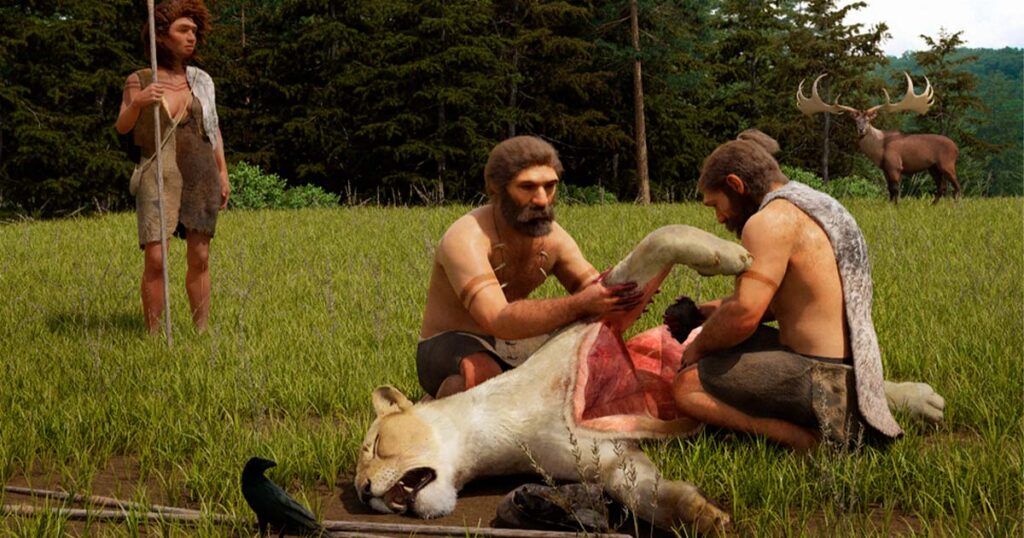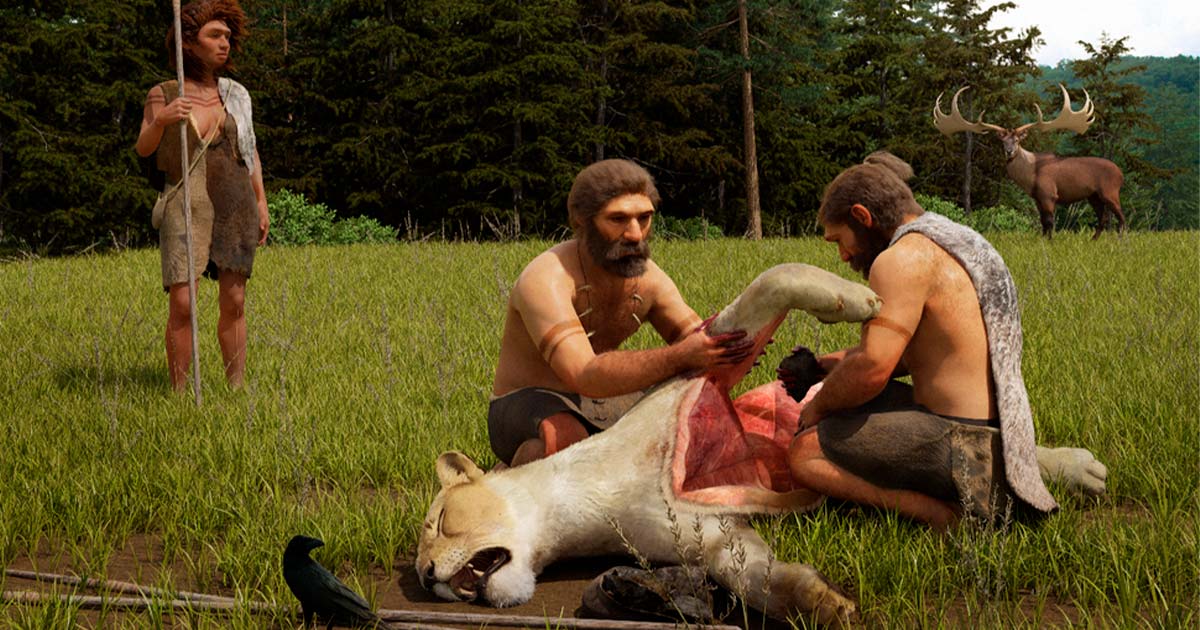

A international team of paleoanthropologists has just published research supposedly proving that Neanderthals were hunting and eating cave lions nearly 50,000 years ago in Europe. Until now experts had no idea that Neanderthals hunters had been stalking cave lions. In fact, this stunning discovery represents the oldest evidence of large predator hunting by human relatives or ancestors found anywhere in the world.
Discovering the Mark of the Neanderthal Hunter
As detailed in the article published in the journal Scientific Reports, the paleontologists analyzed the well-preserved remains of a cave lion skeleton found in Siegsdorf, Germany, which was excavated 38 years ago and dated to approximately 46,000 BC. While the cave lion has been extinct for more than 10,000 years, its skeletal remains have been discovered in many different locations in Eurasia.
At the time the skeleton was found, archaeologists noted right away that the animal had been butchered after its death. There were cut marks on many of its bones, showing that the meat and skin had been removed from the the cave lion after it had died.
But during the recent reanalysis, the international team of researchers, who were led by Dr. Gabriele Russo from the University of Tübingen, noticed something that had been overlooked before. This was the presence of a distinctive puncture wound on the inside of one of the lion’s ribs.
This puncture had previously been identified as a bite mark from a scavenger, but this time the paleoanthropologists were able to rule out this explanation. This indentation was also not consistent with butchering cuts, they noted, but suggested the cave lion had been mortally wounded by some type of sharp object.

The cave lion remains unearthed at Siegsdorf have provided a glimpse into Neanderthal hunting. (Volker Minkus / ©NLD)
The Cave Lions Were Killed by Neanderthal Hunting Spears
After evaluating this intriguing discovery more closely, Dr. Russo and her team eventually came to an astonishing conclusion. The mark on the cave lion remains matched those left on other animal skeletons wounded by wooden-tipped spears once used by the Neanderthal hunter-gatherer groups that occupied northern Europe at the end of the Middle Paleolithic period (around 50,000 years ago).
The researchers arrived at this conclusion after looking at experimental data from tests that involved stabbing animal skeletons with such weapons, to see what kind of marks the spears would leave. They also examined evidence from the skeletons of elephants that had been killed by spear hunters in Africa.
“It [the mark on the rib] fits really well with hunting lesions,” said University of Reading archaeologist Annemieke Milks, during an interview with Science in which she discussed the Neanderthal hunting evidence. “It couldn’t be anything but damage from a spear.”
It could be postulated that this kill was not the result of hunting par se, but just the result of a chance killing, with a hungry predator invading a camp and being picked off with no chase. But the discovery is consistent with many later finds that showed European Neanderthals were hunting big game quite frequently, preying on animals such as deer, wolves, bison and elephants.
“Rich and complex relations with the natural world fits well with what we know about Neanderthal relations to [their] environment,” stated Ludovic Slimak, an archaeologist at the French research center CNRS, who was not involved with the new study.

The team studied the cut marks found on the cave lion skeleton to reach its conclusions about Neanderthal hunters. (Russo et. al / CC BY 4.0 DEED)
The Secrets of the Neanderthal Lion Hunters Revealed
The researchers acknowledge that hunting cave lions would have been a difficult task for ancient Neanderthals, and one fraught with danger if done carelessly. But they note that contemporary African lions spend many hours each day lying on their backs or sides sleeping in the shade, and that older lions do this while living solitary lifestyles, meaning they don’t have their kin around to protect them when they’re vulnerable.
“[Neanderthal] Hunters could have taken advantage of the lion in such a resting position, approaching the animal more safely from behind and stabbing it in the lower abdomen while it was lying on its right side,” the researchers speculate when discussing the evidence of Neanderthal hunters. “This strategic approach bears resemblance to the tactics employed by Upper Paleolithic hunters during the hunt for cave bears in hibernation.”
Based on the condition of its bones, the researchers know that this particular cave lion was old and weak. Because its skeleton was found at Siegsdorf in an open location, they concluded that the animal was butchered by the Neanderthals immediately after its death, with its remains then being left behind at the kill site.
Seeking further confirmation of the meaningfulness of their discovery, Dr. Russo and her team also analyzed bones recovered from three ancient cave lion specimens found during excavations in 2019 at Unicorn Cave in the Harz mountains of northern Germany. These skeletal artifacts, which included small bones from the lower leg and feet, also showed telltale marks consistent with butchering and skinning.
Intriguingly, great care was exercised to make sure the pelt of one of the animals was not damaged, but would remain intact after its removal. This could mean the pelt was used to make clothing, a blanket or a rug. Or it could have been preserved as some kind of trophy, or as an object with spiritual meaning. All of these possibilities would be consistent with what is now known about the Neanderthals, who created a complex culture and were capable of symbolic thinking, just like their Homo sapiens cousins.
There is no direct evidence to show that the cave lions found in Unicorn Cave were hunted rather than scavenged. But it seems reasonable to conclude they were, now that new evidence has emerged proving that Neanderthals weren’t willing to wait for lions to perish from natural causes.

A replica cave painting of cave lions found at the Chauvet Cave in France. The new study has revealed that cave lions would have been stalked and eaten by Neanderthal hunters. (Public domain)
The Magnificent Cave Lion in Ancient Human and Neanderthal Cultures
Cave lions outlasted Neanderthals, but were hunted to extinction by modern humans between 16,000 and 12,000 years ago. Nevertheless, it is clear the big cat had cultural significance to prehistoric Homo sapiens groups living in Europe, as they left behind cave paintings, ivory sculptures and figurines, and perforated cave lion teeth that were worn strung on necklaces.
The new discoveries suggest these awe-inspiring creatures were just as important to the Neanderthals. “I think it was a majestic animal,” Dr. Russo told Science, “and a main character in Neanderthal life.”
Sadly, these two species shared the same ultimate fate, leaving behind only skeletal remains and other ancient remnants that hint at their once-vibrant presence.